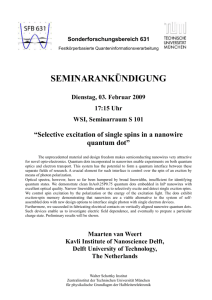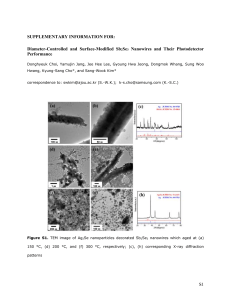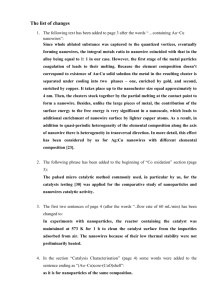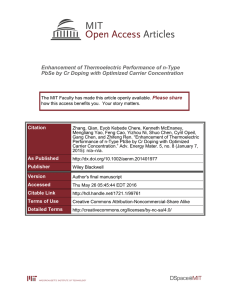Nanowires Debye Lecture 5 C. B. Murray
advertisement
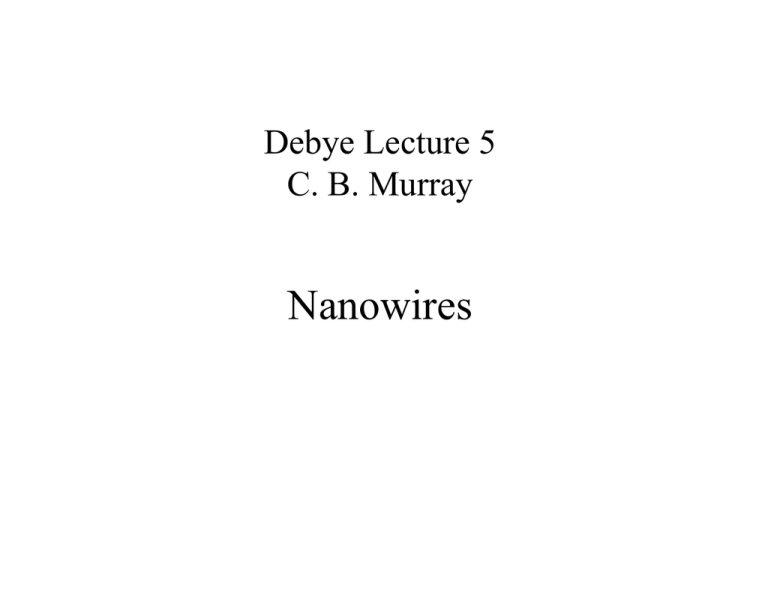
Debye Lecture 5 C. B. Murray Nanowires Size dependence of the band gap energy… decreasing well thickness (d) decreasing dot d InAs Ellis and coauthors J. Chem. Ed. 2001 InP CdSe increasing E Q dot Alivisatos and coworkers Science 1998 increasing E Q wire Eg Q well Quantum dot 3D confinement 1/dn Quantum wire 2D confinement Quantum well (layer) 1D confinement How should the size dependences in wells, wires, and dots compare quantitatively? How should the size dependences of the band gaps (∆Eg values) compare in wells, wires, and dots? Particle-in-a-box models for kinetic energy of confinement: Quantum Well: ∆Eg = (h2/8d2)[1/me + 1/mh] Cylindrical Quantum Wire: ∆Eg = 1.17(h2/8d2)[1/me + 1/mh] Spherical Quantum Dot: ∆Eg = 2(h2/8d2)[1/me + 1/mh] Quantum well Quantum wire Quantum dot • Hypothesis: in plots of ∆Eg vs. 1/d2, the slope of a quantum-wire line should be 0.585 times that of the corresponding quantum-dot line A Laser Ablation Method for the Synthesis of Crystalline Semiconductor Nanowires Alfredo M. Morales and Charles M. Lieber Science, vol 279, p 208 (1998) Growth apparatus Flow controller Pulsed Laser Lens Sample in Quartz Tube Tube Furnace Cold Finger 1-30 µm long 3-20 nm thick Disordered, connected by round nod Coated with SiO2 (10-20 nm) Length limited only by growth chamber TEM of Si Nanowires TEM nanowires Diffraction contrast High Res TEM 0.3 nm 100 nm 10 nm Convergent beam ED The Growth Model Laser Ablation Condensation of Si on Ag Supersaturation and nanowire growth End of Growth (wires exit hot area) TEM of Ge Nanowires Ge and Fe Ge only 9 nm 5 nm 1 nm Silicon Nanowires: In-situ Observation of Growth viewing direction heated substrate Si2H6 110 111 112 110 111 112 Frances Ross, IBM Research dark-field image Si nanowire growth showing wire and drop geometry, facet formation and tapering to termination Frances Ross, IBM Research Solution-Liquid-Solid (SLS) Growth of Semiconductors… Solution t-Bu3M + EH3 protic catalyst 3t-BuH Liquid In,Ga,Al Bi, or Sn Solid InP [111] growth direction (ME)n catalyst particle crystalline semiconductor (ME) Trentler, Hickman, Goel, Viano, Gibbons, Buhro Science 1995, 270, 1791 100 nm • Unsuitable for quantum-wire studies… • Most diameters are far too large (> 20 nm) • Diameter distributions are far too broad • Require monodisperse, small-diameter, catalyst nanoparticles SLS growth of InP nanowires from monodisperse In nanoparticles… Me3Si SiMe3 P Me Me In In P Me Me – SiMe4 203 oC, i-Pr2C6H4 In nanoparticles, polymer stab. Me3Si SiMe3 M.L. Steigerwald et al. 1991 • Polyhexadecene0.67-co- PVP0.33 was used as “surfactant” to stabilize both In nanoparticles and InP nanowires • Nanowire samples were grown using several sizes of monodisperse In particles • The nanowires formed dark-red dispersions that were stable indefinitely • Nanowire samples were analyzed by TEM H. Yu, J. Li, R.A. Loomis, L-w. Wang, W.E. Buhro Nature Mater. 2003, 2, 517 TEM images of InP nanowires: diameter control 9.9-nm In catalyst nanoparticles 4.5-nm InP nanowires 13.9-nm In 6.6-nm InP 21.2-nm In 11.0-nm InP • Nanowire diameters scale with the initial catalyst-nanoparticle diameters • Statistical analyses confirm fairly narrow nanowire diameter distributions • The wires are near single crystals, and are 111 oriented Absorption spectra of InP quantum wires and quantum dots… quantum wires quantum dots Left: absorption spectra; Center: peaks extracted by Gaussian fits and background subtraction Mićić, Nozik, and coworkers Appl. Phys. Lett. 1996 Plots of ∆Eg vs. 1/d2 for InP quantum dots and wires… Recall prediction for the relative slopes of the lines: Awire/Adot = 0.585 InP quantum dots* Adot = 6.1 ± 0.1 eV nm2 *Mićić, Nozik, and coworkers Awire/Adot = 0.62 ± 0.03 InP quantum wires Awire = 3.8 ± 0.2 eV nm2 Thus, quantum confinement is weakened in the wires to the expected extent by the loss of one confinement dimension SLS growth of CdSe nanowires from Bi nanoparticles… Cd(stearate)2 + Se=P(n-Bu)3 240 – 300 oC, TOPO Bi nanoparticles (hexadecylamine) adapted from Xiaogang Peng and coworkers • No polymer stabilizer necessary to retain nanowire “solubility” • Mean nanowire diameters varied with reaction temperature and catalyst nanoparticle size • Indefinitely stable dark-red dispersions • Nanowire specimens were analyzed by TEM; typical lengths: several µm • Statistical analyses: diameter std. dev. = ± 10 – 20% of mean diameter Yu, Li, Loomis, Gibbons, Wang, Buhro JACS 2003, 125, 16168 TEM images of CdSe nanowires… Absorption spectra of CdSe quantum wires… d = 18.83 nm d = 10.42 nm d = 8.44 nm d = 7.91 nm d = 6.70 nm d = 5.25 nm selected absorption spectra peaks extracted by Gaussian fits and background subtraction Plots of ∆Eg vs. 1/d2 for CdSe quantum dots and wires… Recall prediction for the relative slopes of the lines: Awire/Adot = 0.585 *Bawendi and coworkers CdSe quantum dots* Adot = 5.9 ± 0.4 eV nm2 Experiment for CdSe: Awire/Adot = 0.53 ± 0.05 Experiment for InP: Awire/Adot = 0.62 ± 0.03 CdSe quantum wires Awire = 3.2 ± 0.2 eV nm2 T. J. Watson Research Center Mechanisms of Particle and Wire formation Particle Formation and Growth Different Chemical Potential, Injecting Condition, Ligand Concentration Rocksalt Structure <100> SA using Nanoparticles as a Building Block Discontinuous Prorated Particles Wire Formation and Growth Thicker, Continuous, Crystalline (100) PbSe Nanowires acid − TOP, 170 − 250° C Pb(CH 3COO) 2 + (C8H17) 3 PSe ⎯oleic ⎯⎯ ⎯ ⎯ ⎯ ⎯⎯→ PbSe + ... (100) (100) 5 nm PbSe Nanowires (a) 40 nm (b) (c) 40 nm 40 nm Solution Synthesized Nanorwires : Directed Self-Assembly. PbSe:High yield, uniform structure, band gap tunable between 0.75 and 0.5 Good diameter control..Improvement still needed. Deposited w/o field Deposited DC field Straight single crystal NWs for transistors (Bulk PbSe µ =1800 cm2V-1 S-1) Directed self-assembly PbSe NWs (110) PbSe nanowires acid − HDA− TOP, 200° C Pb(CH 3COO) 2 + (C8H17) 3 PSe ⎯oleic ⎯⎯ ⎯⎯⎯⎯⎯ ⎯→ PbSe + ... HDA- hexadecylamine Nanowires for thermoelectric applications phonon e (110) PbSe nanowires zig-zag (110) PbSe nanowires are promising for for thermoelectric applications Shape evolution of PbSe Nanocrystals Highly symmetric rock salt structure 100 111 Branched PbSe nanowires (100) PbSe nanowire-based heterostructures acid − oleyl amine, HAuCl 4, 50° C PbSe nanowire ⎯oleic ⎯⎯ ⎯⎯⎯⎯⎯⎯⎯ ⎯→ PbSe / Au



